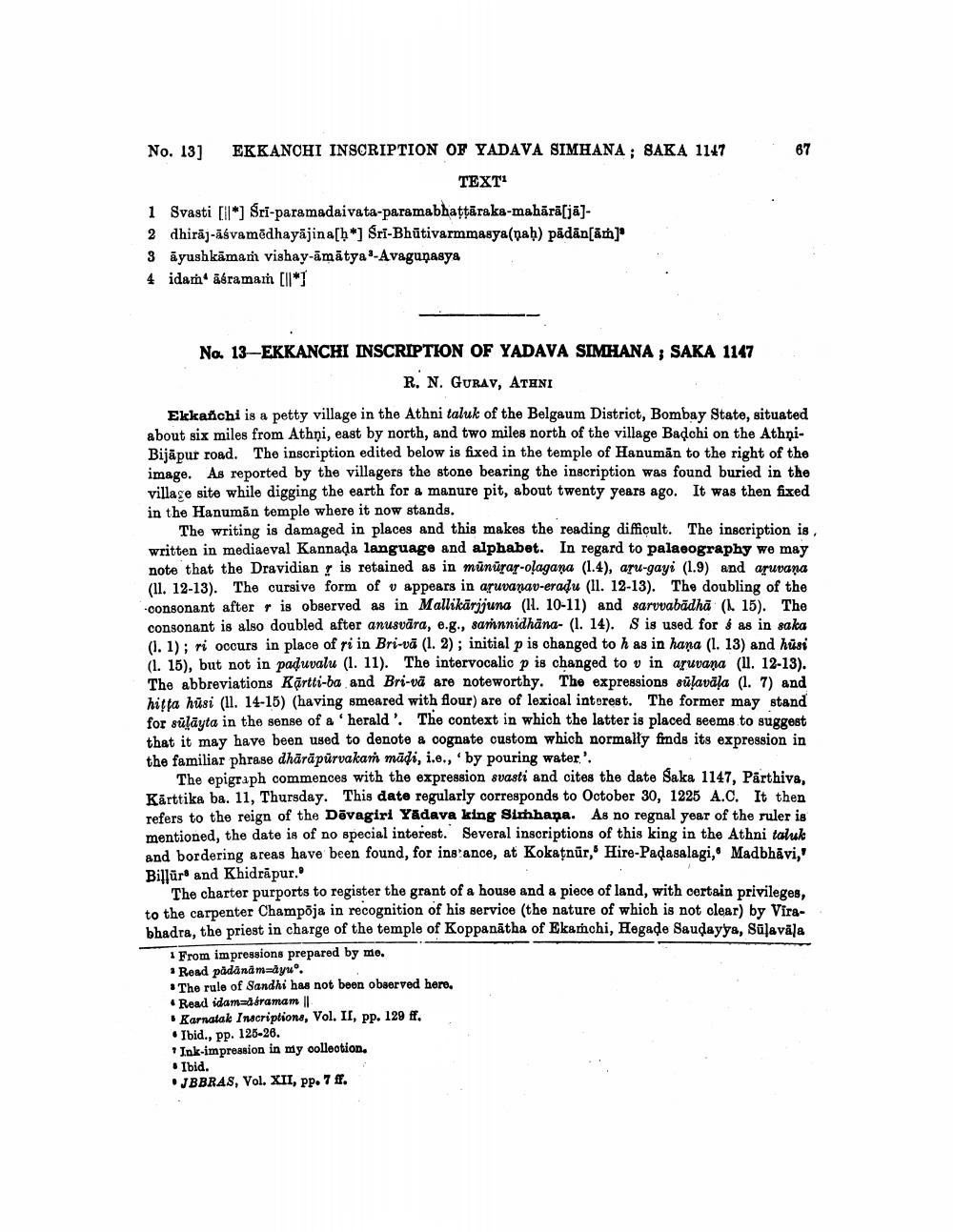________________
67
No. 13] EKKANCHI INSCRIPTION OF YADAVA SIMHANA; SAKA 1147
TEXT: 1 Svasti [11*] Sri-paramadaivata-paramabhattāraka-mahārā[jā]2 dhiraj-asvamēdhayājina[h*] Sri-Bhūtivarmmasya(nah) pädān[ämn]" 3 ayushkāmam vishay-āmātya-Avagunasya 4 idam ābramam [ll*1
No. 13-EKKANCHI INSCRIPTION OF YADAVA SIMHANA , SAKA 1147
R. N. GURAV, ATHNI Ekkanchi is a petty village in the Athni taluk of the Belgaum District, Bombay State, situated about six miles from Athņi, east by north, and two miles north of the village Badchi on the AthņiBijapur road. The inscription edited below is fixed in the temple of Hanuman to the right of the image. As reported by the villagers the stone bearing the inscription was found buried in the villase site while digging the earth for a manure pit, about twenty years ago. It was then fixed in the Hanuman temple where it now stands.
The writing is damaged in places and this makes the reading difficult. The inscription is written in mediaeval Kannada language and alphabet. In regard to palaeography we may note that the Dravidian r is retained as in mūnūrar-olagana (1.4), aru-gayi (1.9) and aruvana (11. 12-13). The cursive form of v appears in aruvanav-eradu (ll. 12-13). The doubling of the consonant after r is observed as in Mallikarjjuna (1l. 10-11) and sarvvabādhā (1. 15). The consonant is also doubled after anusvāra, e.g., saṁnnidhana- (1. 14). S is used for & as in saka 0.1): ri occurs in place of ri in Bri-vă (1.2); initial p is changed to h as in hana (1. 13) and husi (1. 15), but not in paduvalu (1. 11). The intervocalic p is changed to v in aruvana (11. 12-13). The abbreviations Kārtti-ba and Bri-vă are noteworthy. The expressions sulavāļa (1. 7) and hitta hūsi (11. 14-15) (having smeared with flour) are of lexical interest. The former may stand for sülayta in the sense of a 'herald'. The context in which the latter is placed seems to suggest that it may have been used to denote & cognate custom which normally finds its expression in the familiar phrase dhārāpūrvakaṁ mādi, i.e., by pouring water'.
The epigraph commences with the expression svasti and cites the date Saka 1147, Pärthive. Kārttika ba. 11, Thursday. This date regularly corresponds to October 30, 1225 A.C. It then refers to the reign of the Dāvagiri Yadava king Simhapa. As no regnal year of the ruler is mentioned, the date is of no special interest. Several inscriptions of this king in the Athni taluk and bordering areas have been found, for instance, at Kokațnūr, Hire-Padasalagi, Madbhāvi, Billüre and Khidrāpur.
The charter purports to register the grant of a house and a piece of land, with certain privileges, to the carpenter Champôja in recognition of his service (the nature of which is not clear) by Virabhadra, the priest in charge of the temple of Koppanātha of Ekamchi, Hegade Saudayya, Sulavāla
1 From impressions prepared by me. * Read pädanamzayu. * The rule of Sandhi has not been observed hero,
Read idamadáramam || • Karnatak Inscriptions, Vol. II, pp. 129 ff. • Ibid., pp. 125-26.
Ink-impression in my colleotion, . Ibid. • JBBRAS, Vol. XII, pp. 7 ff.




